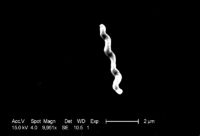Campylobacter jejuni
| This article has been peer reviewed but is awaiting expert review. If you would like to help with this, please see more information about expert reviewing. |
Also known as: —C.jejuni, —C. fetus subsp jejuni, —Vibrio jejuni
| Campylobacter jejuni | |
|---|---|
| Phylum | Proteobacteria |
| Class | Epsilon Proteobacteria |
| Order | Campylobacterales |
| Family | Campylobacteraceae |
| Genus | Campylobacter |
| Species | C.jejuni |
Campylobacter jejuni belongs to the genus Campylobacter. C.jejuni is an important enteropathogen of man and a number of animal species. It is the largest cause of food-poisoning in the UK and is therefore a public health issue. It is widespread on farms and is hyperendemic. It can be carried as commensals in the intestines of cattle, sheep, goats, dogs, cats, rabbits, wild birds and especially chickens. Farm animals are regularly exposed via the faecal-oral route. Maternal antibody protects the animal while the active immunity develops. Animals with little exposure are very susceptible, e.g. humans and pets. Most chicken carcasses are contaminated, leading to food poisoning and enterocolitis in people from uncooked meat. If frozen chicken is inadequately thawed, bacteria may remain viable in the abdominal cavity. It also causes late abortion and still births in sheep and goats, any may also cause mastitis in cattle.
Pathogenesis
The pathogenesis of C.jejuni involves the colonisation, attachment and invasion of colonic enterocytes and toxin production. It causes colitis, characterised by; Necrosis of absorptive epithelial cells; Erosion of the mucosa; Crypt abscesses; The infiltration of inflammatory cells into the mucosa and the presence of primarily neutrophils. The bacteria's functional flagella are important as virulence factors. Non-flagellate campylobacter do not colonise in vivo, and are less invasive. It causes enteritis and diarrhoea in susceptible dogs and causes abortion in ewes. It usually causes asymptomatic infections in chickens and turkeys, but occasional outbreaks of avian hepatitis occur. It is implicated in undifferentiated neonatal calf diarrhoea, a mixed viral enteritis in calves. C.jejuni is diagnosed by laboratory diagnosis.
- An important enteropathogen of man and a number of animal species.
- The largest cause of food-poisoning in the UK.
- Is therefore a public health issue.
- Very widely distributed on the farm- carried in the intestinal tract of:
- Cattle
- Sheep
- Dogs
- Chickens
- Wild birds
- Widespread distribution on the farm means that it is hyperendemic.
- All animals are regularly exposed to it by the faecal oral route.
- Passive (colostral) protection is helpful while active immunity develops.
- There is no regular exposure in the hygienic environment of the human or pet dog.
- These animals are much more susceptible to infection.
- The intestinal contents of the broiler chicken may be spread around the abdominal cavity at slaughter.
- Most poultry is moderately or heavily contaminated.
- If frozen chicken is inadequately thawed, bacteria may remain viable in the abdominal cavity.
- Bacteria may be ingested by humans handling the raw meat.
- Most poultry is moderately or heavily contaminated.
Pathogenesis
- Bacteria colonise the gut, attach to and invade the mucosa, and produce toxin.
- Causes colitis, characterised by:
- Necrosis of absorptive epithelial cells
- Erosion of the mucosa
- Crypt abscesses
- Infiltration of inflammatory cells into the mucosa.
- Primarily neutrophils.
- Functional flagella are important as virulence factors.
- Non-flagellate campylobacter do not colonise in vivo, and are less invasive in vitro.
- Diagnosed by laboratory diagnosis.
Literature Search
Use these links to find recent scientific publications via CAB Abstracts (log in required unless accessing from a subscribing organisation).
Campylobacter jejuni in the UK

